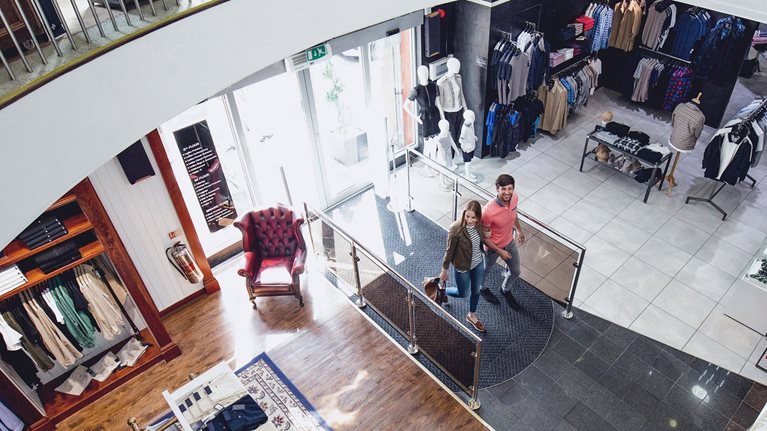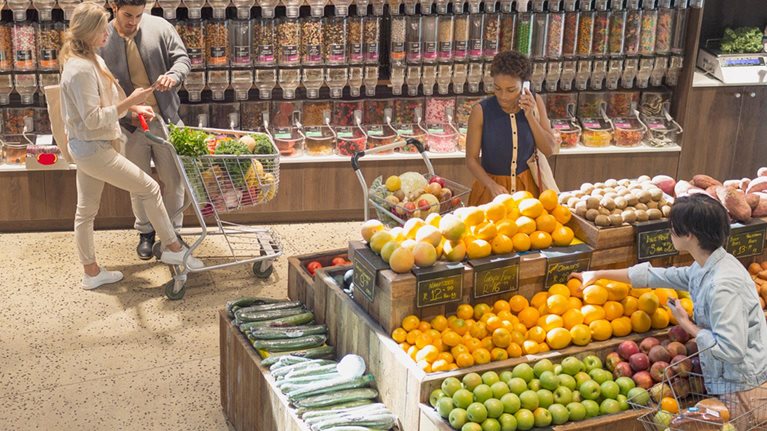Now should be a great time in US retail. Consumer confidence has finally returned to pre-recession levels. Americans have seen their per capita, constant-dollar disposable income rise more than 20 percent between the beginning of 2014 and early 2019.
Stay current on your favorite topics
Yet despite the buoyant economic environment, many brick-and-mortar stores are struggling. In part, that’s due to the rise of e-commerce, which since 2016 has accounted for more than 40 percent of US retail sales growth. In our most recent consumer survey, 82 percent of US shoppers reported spending money online in the previous three months, and the same percentage used their smartphones to make purchasing decisions. Not surprisingly, younger shoppers favor e-shopping even more: 42 percent of millennials say they prefer the online retail experience and avoid stores altogether when they can.
Meanwhile, the strong economy and record-low unemployment are increasing wage pressure and store operating costs. In the last three years, more than 45 US retail chains have gone bankrupt.
Retail stores have a real future
Yet rumors of the physical store’s death are exaggerated. Even by 2023, e-commerce is forecast to account for only 21 percent of total retail sales and just 5 percent of grocery sales. And with Amazon and other major internet players developing their own brick-and-mortar networks, it is becoming increasingly clear that the future of retail belongs to companies that can offer a true omnichannel experience.
Retailers are already wrestling with omnichannel’s demands on their supply chains and back-office operations. Now they need to think about how they use emerging technologies and rich, granular data on customers to transform the in-store experience. The rewards for those that get this right will be significant: 83 percent of customers say they want their shopping experience to be personalized in some way, and our research suggests that effective personalization can increase store revenues by 20 to 30 percent.
Several new technologies have reached a tipping point and are set to spill over onto the retail floor. Machine learning and big-data analytics techniques are ready to crunch the vast quantities of customer data that retailers already accumulate. Robots and automation systems are moving out of factories and into warehouses and distribution centers. The Internet of Things allows products to be tracked across continents, or on shelves with millimeter precision. Now is a great time for retailers to embrace that challenge of bringing technology and data together in the offline world.
Would you like to learn more about our Operations Practice?
The evolving consumer journey
How will these technologies reshape the shopping experience? To find out, let’s follow one consumer on a journey through the store of future (Exhibit 1). As Jonathan arrives at his favorite grocery retailer, the store recognizes him, its systems alerted to his presence either as his smartphone connects to the in-store Wi-Fi, or perhaps by a facial-recognition technology that he has signed up to use. Once Jonathan agrees to log in, the store accesses the shopping list he’s been building at home by scanning items with his phone as he uses them up. As he walks the aisles, smart shelf displays illuminate to show the location of those items, while also highlighting tailored offers, complementary items, and regular purchases that didn’t make it onto the list.

Jonathan is tempted by a new, personalized promotion that pops up on his phone as he approaches the prepared-meals aisle. But because he prefers organic foods, he wonders about the product’s ingredients. As he scans the package with his smartphone, an augmented-reality display reveals the origin of its contents, along with its nutrition information and even its carbon footprint.
His bag full, Jonathan leaves the store. There was no need to check out: RFID scanners and machine vision systems have already identified every item he packed, and his credit card, already on file in the retailer’s systems, is debited as he passes through the doors.
The evolving associate and manager journeys
Technology won’t just re-shape the customer experience in tomorrow’s stores: working in retail will look very different too (Exhibit 2). David works part time as an associate in the store’s fresh-foods department, fitting in shifts around his studies and family life. He negotiates his schedule each week using a mobile app. The store runs a bidding system, and staff can earn a premium by volunteering for busy or hard-to-fill shift. The technology also makes it easy for David to trade shifts when he has a conflict.

The store rarely struggles to get the people it needs, however. David loves working there because he is passionate and knowledgeable about food. His duties include some manual tasks including stocking or picking for online orders, but the work is light. Sensors on and above the shelves monitor the status of stock, a machine-learning system plans the replenishment schedule, and items are delivered or taken away by robot carts that glide silently and safely through the store.
David spends most of his time interacting with customers, offering advice on new products and recipes, or answering their questions. He has a hand-held terminal that he can use to call up information on each customer’s preferences and shopping habits. If a customer can’t find something on the shelves, he can pinpoint the location and real-time stock level of every item at a glance, or suggest different items based on that customer’s shopping habits.
Meanwhile, Rebecca, the store manager, is thinking about plans for a big new promotion that starts next week. The project will involve significant changes to the range of items on display including setting new fixturing in the produce area. But that’s nothing new: the store is always adapting its stock and presentation, and Rebecca spends most of her time working with colleagues to improve and fine tune its offerings. It helps that many previously time-consuming tasks, like associate scheduling and reporting, are now handled automatically by artificial-intelligence tools. Her phone alerts her when a situation needs real attention in real time, such as a promotion that’s not selling as well as in other stores. That means she can focus her efforts on performance and service improvements, aided by the store’s sophisticated performance-analysis systems.
David and Rebecca already have a pretty good idea how the new promotional set will work because they’ve tried it out in virtual reality, using an interactive digital twin of the store. Conversations with customers have given them an idea for tweaking the offer’s presentation, and they are discussing the possible changes now to boost sales, rather than rigidly adhering to a formula devised handed down from above.

Technology + operations: A flywheel for performance improvement
The financial impact of in-store technology
There’s another area that is set to look very different in the store of the future, and that’s the store’s P&L sheet. And while our example has been taken from grocery retail, this impact will be noticeable across the sector. Personalized offerings and optimized assortments will likely raise sales and cut waste, while opportunities to upsell and cross-sell, either automatically or in person, can increase basket sizes and conversion rates.
The profile of the workforce will change as well: skilled and knowledgeable associates will expect to earn more, pushing hourly rates up by about 20 percent. Total wages are likely to fall, however, as automation and technology help shift the balance of labor spend toward value-added and customer-facing work.
Overall, we believe the Store of the Future is likely to achieve EBIT margins twice those of today, with the added benefits of improved customer experience, better employee engagement, and an easier-to-run store (Exhibit 3). The technology necessary to achieve this transformed P&L is available now, and we calculate that it is ROI-positive.

Are you ready?
The store of the future is still in its infancy, but every one of the technologies described above exists today and as a commercial product, not just a prototype or proof-of-concept. Retail leaders should act now to prepare their organizations for a technology-enabled revolution in customer experience and efficiency. Ask yourself how your organization is doing:
- Do you understand the level of performance your network will need to achieve over the next decade?
- Have you identified the primary use cases for technology-enabled improvements to efficiency or customer experience?
- Are you already testing and piloting new technologies in store or across the network?
- Do you have the capabilities to ramp up your use of technology- and data-driven retail innovations?
In forthcoming articles, we’ll take a closer look at the technologies that are shaping the store of the future, and how they are set to transform retail P&L.


